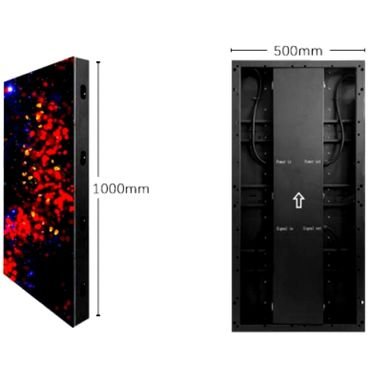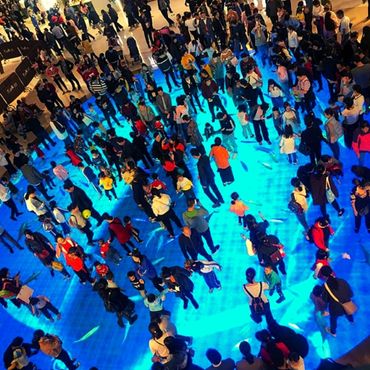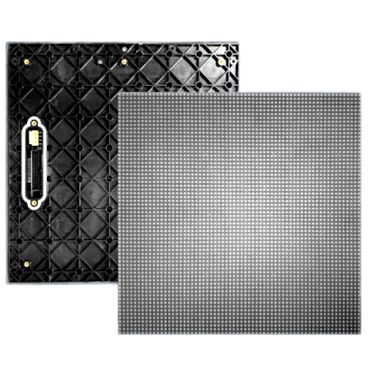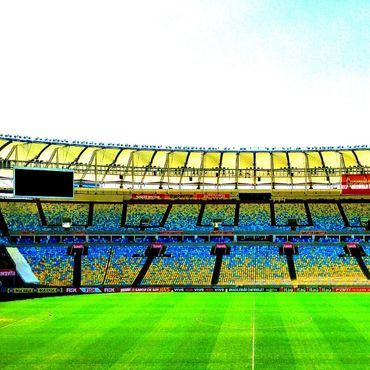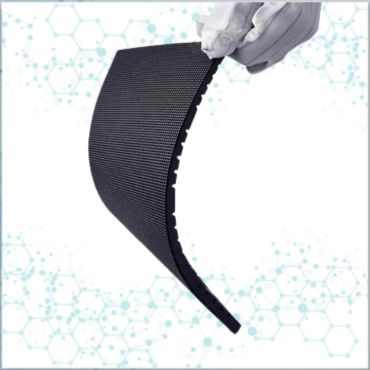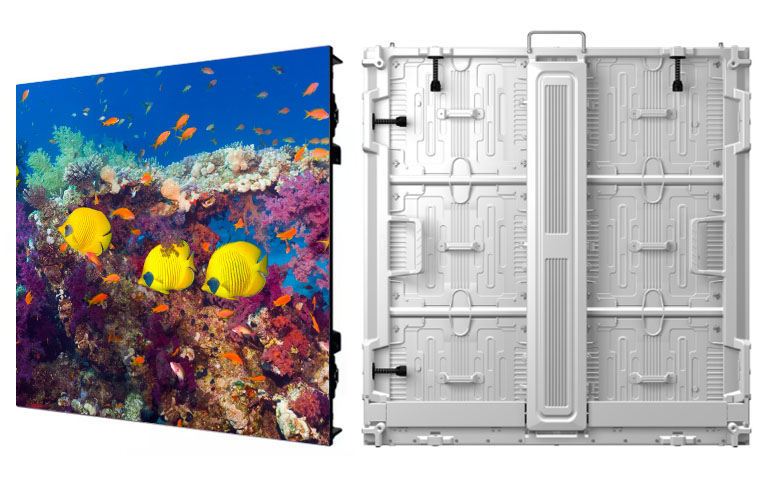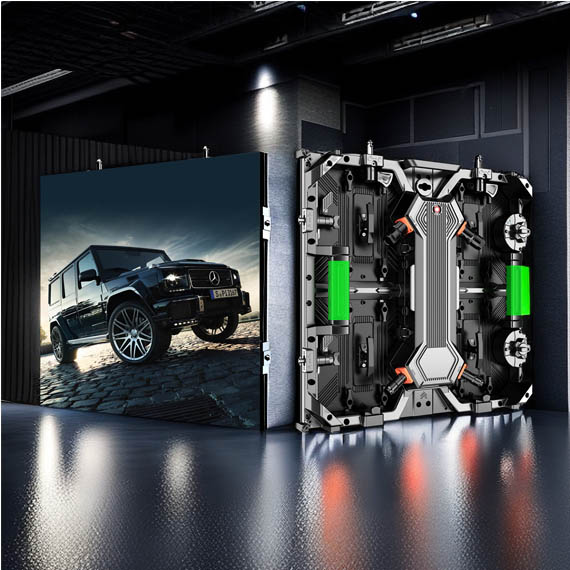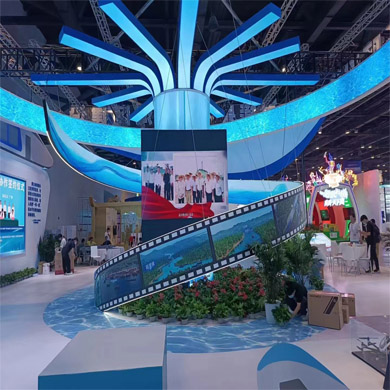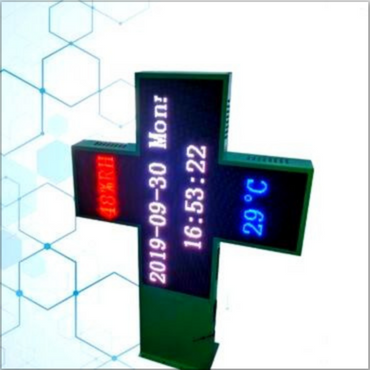Dance Floor LED Screen
| Pixel Pitch | P2.976-P3.91-P4.81 |
|---|---|
| Cabinet size | 960*960mm,960*800mm,900*900mm |
| Module size: | 500*1000mm |
| Refresh rate: | 3840Hz |
| Power: | Max:800W/sqm,Avg:250W/sqm |
| Waterproof : | IP43 |
| Brightness: | 4000cd |
| Input Voltage: | 110-220V |
Interaction method of interactive Dance floor LED Screen?
The interactive Dance floor LED Screen has rich and diverse interactive functions, which can bring users a very interesting and engaging experience. The following are some common interactive functions:
1. Tactile interaction
Footstep trigger: When people step on the floor tile screen, the screen will trigger corresponding visual effects based on the location and intensity of the foot step. For example, when you step on the floor tiles, the effect of water ripples will appear, or flowers bloom from the soles of your feet. As you move, the flowers gradually bloom and spread out, creating a romantic atmosphere of walking among flowers.
Pressure-sensitive games: Use pressure sensors to design some simple interactive games. For example, different areas are divided on the floor tile screen, and each area corresponds to a different score. Participants accumulate points by stepping on different areas to see who scores the highest within the specified time. This kind of game can be used in shopping mall promotions, children’s playgrounds and other places to attract the participation of customers and children.
2. Action interaction
Gesture recognition: Through the built-in camera or infrared sensor, the floor tile screen can recognize the gestures of participants. For example, when people wave or clap their hands above the floor tile screen, the picture on the screen will change accordingly. For example, waving your hands can switch between different screen scenes, and clapping your hands can make small animals on the screen jump or run, which increases the fun and flexibility of interaction.
Body movement tracking: Not only can it recognize gestures, but it can also track the overall movement of the human body. In some dance teaching or somatosensory games, the floor tile screen can capture the participants’ dance steps and body postures in real time, compare them with the preset dance movements, and provide feedback and guidance to the participants.
3. Sound interaction
4.Multi-person interaction
5.Environment interaction
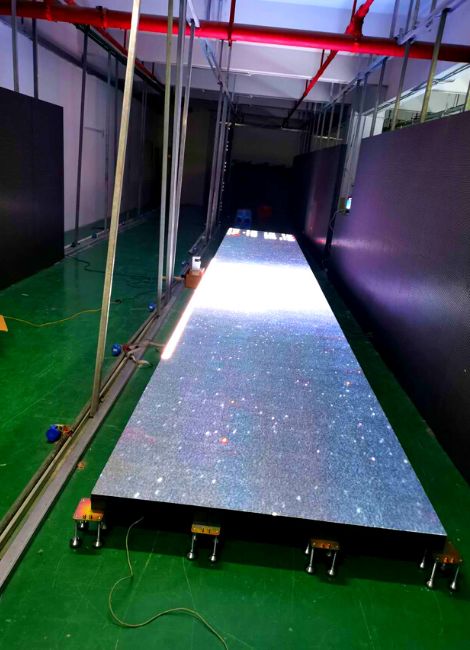
TSLED Dance floor LED Screen Advantages:
- Datasheets
| LED Dance floor | TRO-2.604 | TRO-2.976 | TRO-3.91 | TRO-O4.81 |
| Pixel pitch(mm) | 2.604 | 2.976 | 3.91 | 4.81 |
| Pixel Density(dot/m2) | 112910 | 112910 | 65746 | 43264 |
| LED Type | SMD 1415 | SMD 1415 | SMD 1921 | SMD 1921/2727 |
| Module Size(W x H x D)mm | 250 x 250 | |||
| Module resolution(W x H) | 96 x 96 | 84 x 84 | 64 x 64 | 52 x 52 |
| Module Weight(Kg) | 0.55 | 0.55 | 0.6 | 0.6 |
| Diver Mode(Scan) | 24Scan | 21Scan | 16Scan | 13Scan |
| Brightness(cd/m2) | ≥3,000 | ≥3,000 | ≥3,000 | ≥3500 |
| Grey Scale(bits) | 16 | 16 | 16 | 13 |
| Refresh Rate(Hz) | ≥3,840 | ≥3,840 | ≥3,840 | ≥3,840 |
| Cabinet Size(W x H x D)mm | 500 x 1000 x 80 | |||
| Cabinet Weight(Kg/Cabinet) | 22 | 22 | 22 | 22 |
| Max Power(W/m2) | 800 | 800 | 800 | 800 |
| Average Power(W/m2) | 300 | 300 | 300 | 300 |
| View Angle(H°/V°) | 160°/160° | 160°/160° | 160°/160° | 160°/160° |
| Mini View Distance(m) | 2 | 3 | 3 | 4 |
| Operating Use Temperature(℃) | -20℃~60℃ | |||
| Storage Use Temperature(℃) | -20℃~60℃ | |||
| Input Voltage(V) | 100~240V | |||
| Input Power Frequency(Hz) | 50Hz~60Hz | |||
| Failure Rate | <1/100,1000 | |||
| Signal Input Format | SDI, RGBHV,YUV,YC,Composite,HDMI,DVI,SD/HD-SDI etc. | |||
| Life Time(hrs) | 100000 | |||
| IP Level(front/rear) | IP54 | |||
Common interactive technologies for Dance Floor LED Screen include the following:
Pressure-sensing interactive technology: When pedestrians step on the Dance Floor LED Screen, the pressure sensor under the screen will immediately sense the pressure change. Through preset programs, the pressure on different areas can trigger corresponding special effects. For example, when a person steps on the virtual “water pool” area, a ripple effect will appear; when a person steps on the “piano key” area, a note will be played. This technology is highly accurate, can achieve more delicate interactions, and can be well adapted to static or dynamic displays. The disadvantage is that the sensor may experience a decrease in sensitivity under long-term pressure and requires regular calibration and maintenance.
Infrared sensing interactive technology: Use infrared sensing devices to capture infrared rays emitted by the human body. Once the human body is detected to be approaching or moving, a signal is sent to the control system to initiate corresponding screen changes. For example, when a person approaches, the surrounding advertising screens will automatically light up, switch, or guide arrows will appear. Its advantage is that it has a wide sensing range, can capture the actions of multiple people at the same time, and can create a lively atmosphere in multi-person interaction scenarios; its disadvantage is that it is easily affected by external infrared interference sources such as strong light, and its stability is poor.
Capacitive sensing interactive technology: Recognize interactive operations based on changes in capacitance between the human body and the screen. By lightly touching the screen surface with your finger, you can control the screen like a capacitive touch screen mobile phone and implement commands such as clicks and slides. It performs well when used to display fine graphics and mini-game interactions, and provides rapid interactive feedback; however, the production cost is relatively high, and it is sensitive to the humidity of the environment in which it is used. Misjudgments may occur when the humidity is high.
Radar sensing interactive technology: Monitor the movement status of objects in the area in real time by transmitting and receiving radar waves. It can accurately track the trajectory and speed of pedestrians, allowing the picture to move with people, such as creating an immersive time-travel tunnel special effect, and the picture continuously switches scenes as people move forward. Its sensing accuracy is extremely high, it can cover a large area and adapt to complex terrain; however, the equipment is expensive, difficult to install and debug, and requires high professionalism from the operators.
Sound Interactive
Sound triggering effect: The Dance floor LED Screen can be combined with a sound sensor to trigger corresponding visual effects when sound is detected. For example, at a music performance site, as the music rhythm changes, the color and pattern of the lights on the floor tile screen will also change, creating a strong audio-visual synchronization effect and enhancing the audience’s immersion.
Voice control: Through voice recognition technology, participants can use voice commands to control the content display on the floor tile screen. For example, in the exhibition hall, visitors can ask questions through voice, and the floor tile screen will display relevant pictures, videos or text introductions based on the content of the questions, providing visitors with a more convenient and personalized visiting experience.
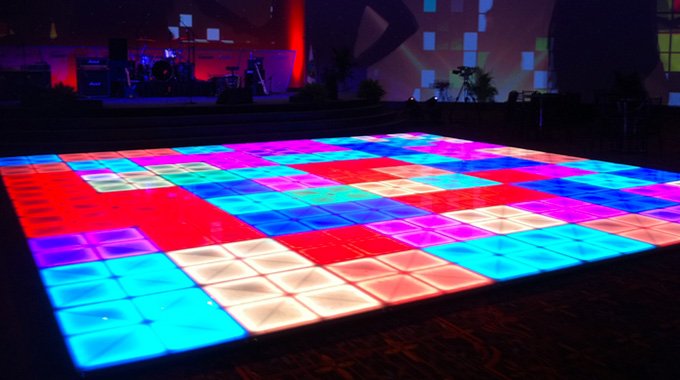
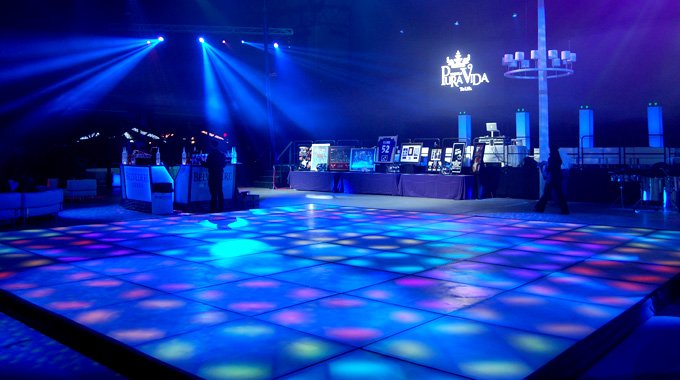
Multi-person Interactive
Team collaboration games: Design games that require multi-person collaboration to promote teamwork among participants. For example, set up a maze on the floor tile screen, and multiple participants need to cooperate with each other and step on the correct path to help the small ball in the maze reach the end point smoothly. In this process, participants need to communicate, work together, and solve problems together, which enhances team cohesion and interactive fun.
Social interaction experience: In some social occasions, such as parties, weddings, etc., floor tile screens can provide a platform for social interaction among many people. For example, set up an interactive photo area. When multiple people stand on the floor tile screen, the screen will display interesting photo props and backgrounds. Participants can select different props and backgrounds by touching the virtual buttons on the floor tile screen, and then take photos. , photos can be shared to social media in real time, making the event more interesting and topical.
environment Interactive
Interact with ambient light: The Dance floor LED Screen can be equipped with a light sensor to automatically adjust the screen brightness according to the intensity of the surrounding ambient light. In a darker environment, the screen brightness will be reduced to reduce energy consumption and protect participants’ eyes; in a brighter environment, the screen brightness will be increased to ensure that the picture is clearly visible. This intelligent environmental adaptation function improves the comfort and energy-saving effect of the floor tile screen.
Interact with environmental sounds: In addition to interacting with man-made sounds, floor tile screens can also interact with natural sounds in the environment. For example, in outdoor parks, floor tile screens can capture natural sounds such as birdsong and wind, and then trigger corresponding natural scenes, such as birds flying, leaves swaying, etc., making people feel as if they are in a more realistic natural environment, enhancing The interactive experience between man and nature.
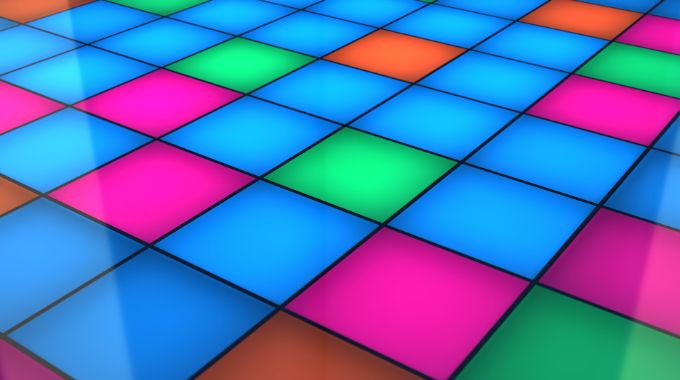
Related Product
One-Stop Solution for Show LED screen Needs.
When purchasing an LED floor tile screen, you must pay attention: the surface must be covered with anti-slip and wear-resistant transparent materials, which can not only clearly show the picture, but also ensure the safety of pedestrians and avoid slipping accidents.
Choosing the LED floor tile screen interactive technology that suits your own needs requires comprehensive consideration of many factors.
The first is the application scenario. If it is used in areas with dense pedestrians and frequent interactions, such as indoor shopping malls and exhibition halls, pressure-sensing interactive technology is more suitable. It can accurately capture the footsteps of pedestrians, trigger rich special effects, and create a novel shopping and exhibition experience for customers, like creating a dreamy “flower sea trail” where flowers bloom wherever people walk. Infrared sensing technology has outstanding advantages in open spaces such as large-scale commercial event sites and open exhibition hall entrances. It can sense the approach of crowds from a long distance and switch display content in time to attract attention, such as dynamic instructions to guide people to enter before the event.
Secondly, we must consider the requirements for interaction refinement. If you need to display high-definition graphics and text and hold interactive games, capacitive sensing interactive technology is the first choice. With precise control similar to that of a mobile phone touch screen, participants can smoothly click and drag to realize complex game logic, such as puzzles, Lianliankan and other interactive games. On the contrary, for scenes that do not require high precision and pay more attention to the rendering of the overall atmosphere, such as around the outdoor music festival stage, radar sensors or infrared sensors are sufficient. They can quickly capture the large-scale movement of the crowd, and cooperate with dynamic music to make the stage lighting and floor tiles The screen image moves with the rhythm of the crowd.
Budget is also a key decision factor. When the budget is limited, the cost of pressure sensing and infrared sensing technology is relatively low, and the initial equipment purchase, installation and subsequent maintenance costs are within an affordable range, and can meet basic interactive needs. If you are not short of money and are pursuing the ultimate interactive experience, capacitive sensing, especially high-end radar sensing technology, is worth considering. Although the initial investment is large, it can create a unique and shocking immersive interactive space, such as the interstellar theme exhibition hall of a high-end science and technology museum.
Furthermore, the characteristics of the use environment cannot be ignored. In outdoor places with frequent strong light exposure, infrared sensors are susceptible to interference. At this time, radar sensors or pressure sensors are more reliable. In indoor venues with high humidity, such as around swimming pools, capacitive sensors should be avoided to prevent misjudgments and pressure sensors should be used. Induction or infrared induction can ensure stable operation.
Finally, ease of maintenance is equally important. Sites lacking maintenance by professional technicians should avoid installing and debugging complicated radar sensing technology and choose pressure sensing, a technology that is simple to understand and easy to calibrate, to ensure that interactive functions are always normal in daily operations.




